| Article ID | Journal | Published Year | Pages | File Type |
|---|---|---|---|---|
| 1456783 | Cement and Concrete Research | 2012 | 9 Pages |
This study attempts to correlate the total amount of chloride bound in concrete with the amounts bound by different hydration products. New insights in the quantities of the hydration products formed will be used in order to predict the phase assemblage of hardened cement pastes. The two main chloride binding mechanisms are considered — through physical adsorption and through chemical reactions. Chloride binding isotherms are used, taking into account the external chloride concentration and the quantity of each hydration product formed.A distinction is made between the chloride binding capacities of monosulfate and hydroxy-AFm. Two new models for the maximum chloride binding ability of a hardened cement paste are proposed — a basic one, using only AFm and C-S-H isotherms, and an extended one which also considers the ability of portlandite and Friedel's salt to physically adsorb chlorides. Results obtained using these models are within 10% of collected experimental data.
